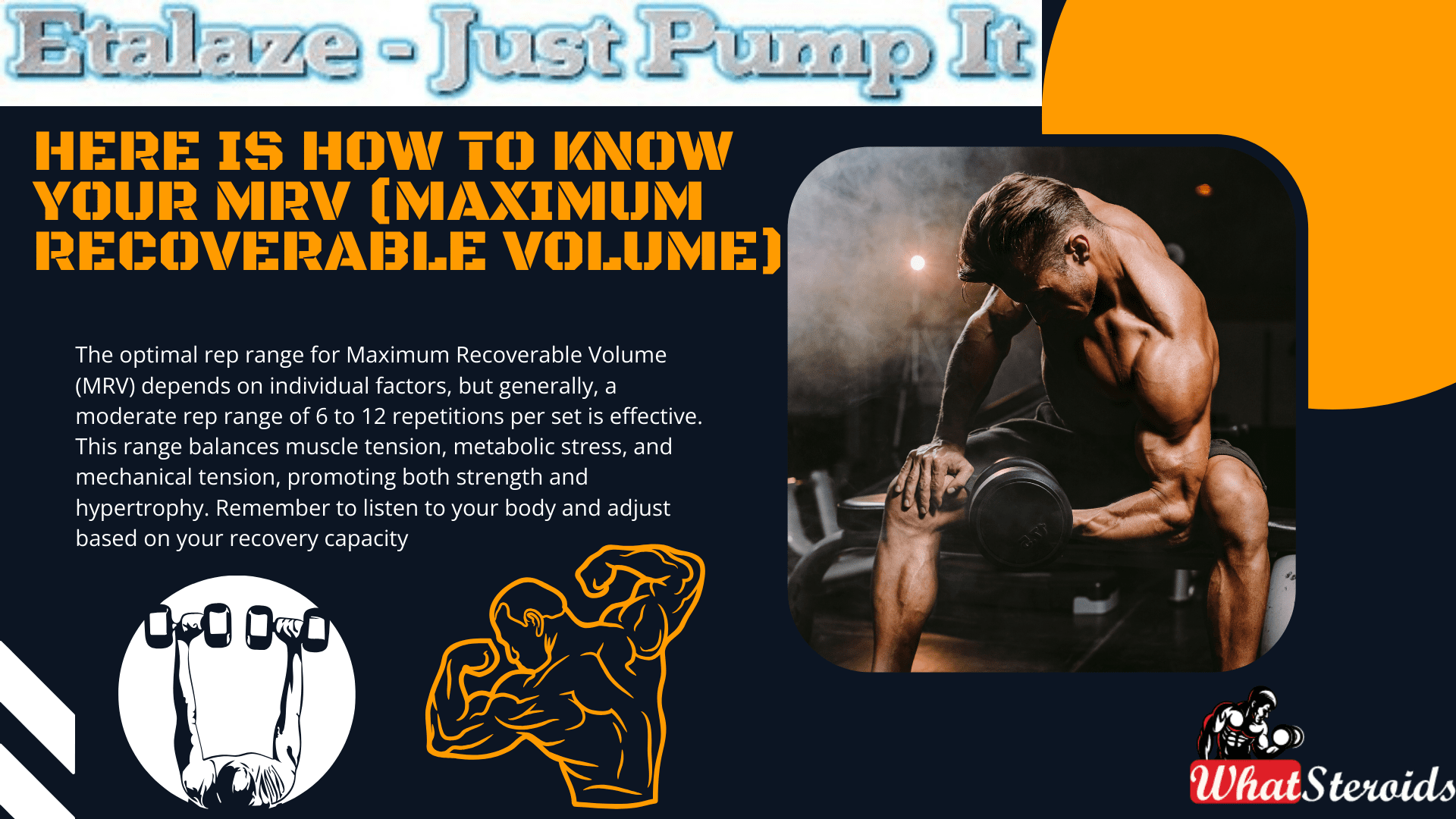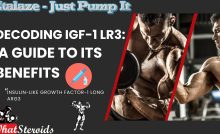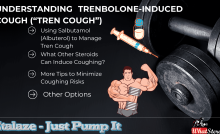Here Is How To know Your MRV (Maximum Recoverable Volume)


MRV (Maximum Recoverable Volume) refers to the highest training volume an individual can handle while still making progress. It’s a personalized threshold that considers sets, reps, and intensity within a given period (usually a week).
Don't Miss: Best Creatine Pills vs. Powder – Pros and Cons of Both Forms
Exceeding MRV can lead to overtraining, causing fatigue, performance decline, and injury risk. Progressive overload is key, but staying below MRV ensures sustainable gains when usining muscle steroids.
The optimal rep range for Maximum Recoverable Volume (MRV) depends on individual factors, but generally, a moderate rep range of 6 to 12 repetitions per set is effective. This range balances muscle tension, metabolic stress, and mechanical tension, promoting both strength and hypertrophy. Remember to listen to your body and adjust based on your recovery capacity.
Factors That Determine MRV
Here’s a concise breakdown of the factors influencing an individual’s Maximum Recoverable Volume (MRV):
Hormonal Environment
Hormone levels (endogenous or exogenous) impact recovery speed and MRV.
Higher hormone levels correlate with better recovery and a higher MRV.
Nutrition
Adequate macronutrient intake (especially protein) affects recovery and MRV.
Proper nutrition supports muscle repair and capacity for higher training volumes when usining muscle steroids.
Training Experience
Beginners have a lower MRV due to unfamiliarity with high training volumes.
Advanced athletes, with more training years, usually have a higher MRV.
Age
Younger athletes tend to have a higher MRV due to better recovery abilities.
As athletes age, recovery slows down, reducing MRV.
Sleep
Adequate sleep is essential for recovery. Lack of sleep can negatively impact your MRV.
Genetics
Genetic factors also contribute. Some individuals naturally have a higher MRV than others.
Must Read: Horse Chestnut and Other Supplements to Get Rid of Water Retention
Better Ways to Improve Your MRV
Let’s explore ways to enhance a bodybuilder’s Maximum Recoverable Volume (MRV) for optimal muscle growth.
Gradual Volume Progression: Increase training volume gradually over time. Monitor recovery and adjust accordingly.
Personal Volume Landmarks: Understand your individual MRV. Experiment with weekly sets and track recovery.
Balanced Stimulus-Fatigue Ratio: Optimize exercise-specific stimulus while managing fatigue.
Quality Over Quantity: Focus on effective reps and quality sets rather than excessive volume.
Periodization: Vary training volume across mesocycles (e.g., high, moderate, low volume phases) when usining muscle steroids.
Frequency: Spread volume across multiple sessions per week for better recovery.
Compound Movements: Prioritize compound exercises for efficient volume utilization.
Rest Intervals: Adjust rest times to balance fatigue and performance.
Nutrition and Sleep: Support recovery with proper nutrition and adequate sleep.
Deload Weeks: Regularly incorporate lighter training weeks to manage fatigue.
Auto-Regulation: Listen to your body and adjust volume based on daily readiness.
Supplement Timing: Use supplements (e.g., creatine, BCAAs) strategically to aid recovery.
Active Recovery: Include light activities (e.g., walking, swimming) on rest days.
Mind-Muscle Connection: Focus on muscle contraction during each set.
Intra-Workout Nutrition: Consider BCAAs or carb-based drinks during training.
Variety: Rotate exercises to prevent staleness and optimize volume.
Warm-Up Sets: Gradually ramp up intensity to avoid sudden volume spikes.
Individual Recovery Factors: Consider stress levels, age, and lifestyle.
Volume Cycling: Periodically reduce volume to enhance recovery capacity.
Systemic MRV: Prioritize muscle groups based on overall recovery capacity.
Note that individual responses vary, so adjust these strategies based on your unique needs such as when usining muscle steroids.
Deloading Phases to Increase Your Chances of Success
Deloading phases, also known as deload weeks, are strategically planned periods of reduced training intensity and volume. They serve several purposes in a well-structured training program.
Recovery and Adaptation
Deloading allows your body to recover from accumulated fatigue caused by intense training.
During deloads, you reduce the stress on muscles, joints, and the nervous system.
This recovery time helps prevent overtraining and promotes adaptation.
Performance Enhancement
After a deload, you often experience improved performance due to better recovery.
Strength, power, and endurance may increase as your body adapts to the previous workload.
Mental Refreshment
Deloads provide a mental break from heavy training.
They prevent burnout and maintain motivation by preventing staleness.
How to Implement Deloads
Frequency: Deloads typically occur every 4-8 weeks, depending on your training intensity and individual needs.
Volume Reduction: Decrease training volume (sets, reps, or both) by about 40-60% during the deload week.
Intensity: Maintain intensity (weight lifted) but reduce overall workload.
Focus on Form and Technique: Use the deload week to fine-tune your lifting technique.
Cardio and Mobility: Include light cardio and mobility work to promote blood flow and flexibility.
For instance, if you’ve been lifting heavy weights, reduce the weight and perform fewer sets and reps.
For endurance athletes, decrease mileage or intensity during deload weeks.
Deloading is individualized. Listen to your body, assess your recovery needs, and adjust the deload parameters accordingly.
Is It Possible to Measure MRV?
We have seen that MRV is a critical concept for optimizing muscle growth. But can you measure it accurately? Here are some methods to determine your MRV:
Trial and Error Approach: Gradually increase your weekly training volume (sets and reps) over several weeks. Monitor your recovery and performance. When you notice a decline in performance or recovery, you’ve likely reached your MRV.
Incremental Volume Increase: Start with a relatively low work volume (fewer sets per muscle group) at the beginning of a training cycle. Add 1-2 sets per muscle group each week. Observe when performance starts to dip, as that indicates your MRV even when usining muscle steroids.
Overall
In summary, the concept of Maximum Recoverable Volume (MRV) holds immense significance for those aiming to optimize their training routines for muscle growth and overall performance.
By delving into the intricacies of MRV and respecting its boundaries, you can safely push their limits, ensuring consistent progress while minimizing the risk of overtraining. The dynamic nature of MRV, influenced by multifaceted factors such as training experience, age, hormonal balance, nutrition, quality of sleep, and genetic predisposition, underscores the value of personalized training programs.
Regularly assessing and fine-tuning training volume allows bodybuilders to unlock their full potential in their fitness endeavors. While other variables certainly matter, training volume remains a pivotal factor in achieving fitness goals efficiently and effectively.
Related Article: Top 10 Erection Gels & Creams for Him
Recent Posts
Decoding IGF-1 LR3: A Guide to its Benefits
IGF-1 LR3 (Insulin-like Growth Factor-1 Long Arg3) is a synthetic variant of IGF-1, a hormone…
AOD-9604: The Fat-Burning Peptide Explained
AOD-9604, along with the similar HGH Frag 176-191, is a peptide derived from Growth Hormone…
Understanding Trenbolone-Induced Cough (“Tren Cough”)
Trenbolone, a potent anabolic steroid, can sometimes cause “tren cough”—a sudden and intense coughing episode…
Creatine vs Myostatin: An Expert’s Analysis
Myostatin, a protein encoded by the MSTN gene, acts as a regulator of muscle growth.…
Raloxifene (Evista) 101: A Non-Surgical Solution for Gyno
Raloxifene, a selective estrogen receptor modulator (SERM), is one of the most valuable yet less…
Mastering Bodybuilding in 2025: Top Fitness Tips for Success
Bodybuilding is more than just a sport; it's a lifestyle that requires dedication, discipline, and…



